Excerpts from Jim Conrad's
Naturalist Newsletter
Entry from field notes dated July 2, 2022, taken on the eastern lower slope of Cerro de la Cruz, at an elevation of ~2700m (~8850 ft), just south of the community of El Pinar, Amealco de Bonfil, Querétaro, MÉXICO, (~N20.17°, ~W100.17°)
SOUTHERN FALSE SERVICEBERRY
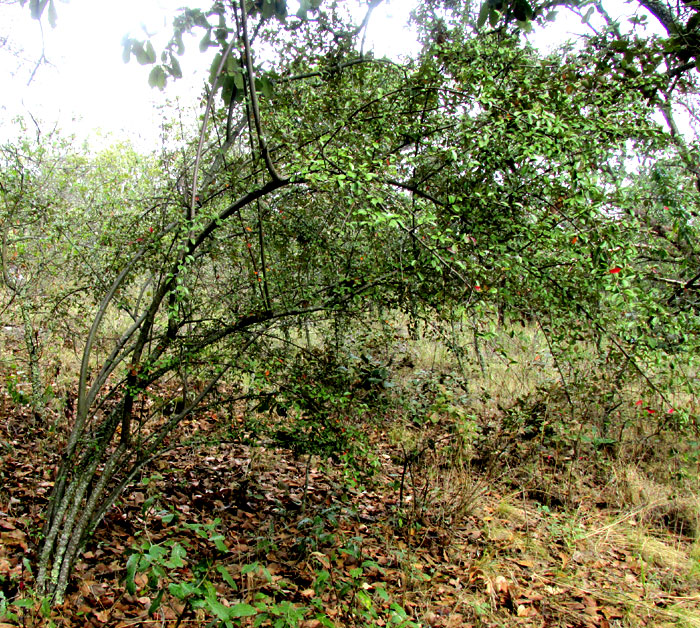
On the lower eastern slope of Cerro de la Cruz, at the edge of the mountain's oak forest, a small, spindly tree leaned toward sunlight scorching a large abandoned field covered mostly with scattered shrubs and clumpgrass, shown above. Maybe five of the tree's branches bore small, white flowers, with one shown below:
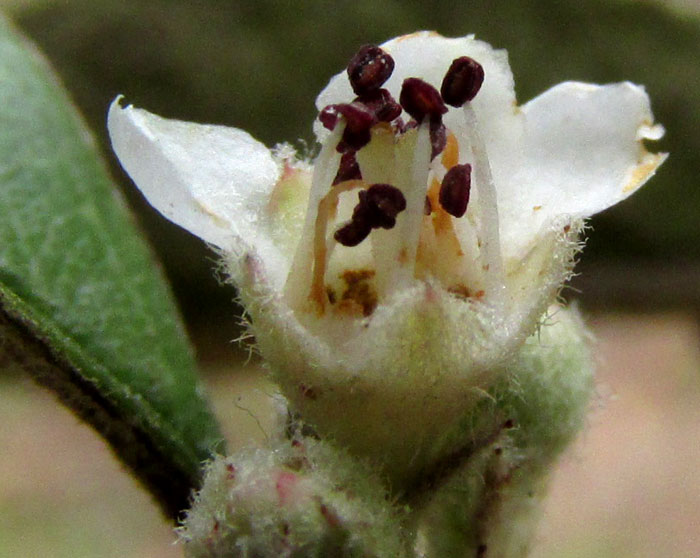
They were the first to open among several clusters of plump, fuzzy buds occurring here and there on the tree. The above blossom has the nearest two of its five petals removed so the normally 20 stamens can be seen, with their black anthers atop slender, white filaments. It's a small flower, only about 1cm across (3/8 inch). The calyx and bud scales are very white-woolly.
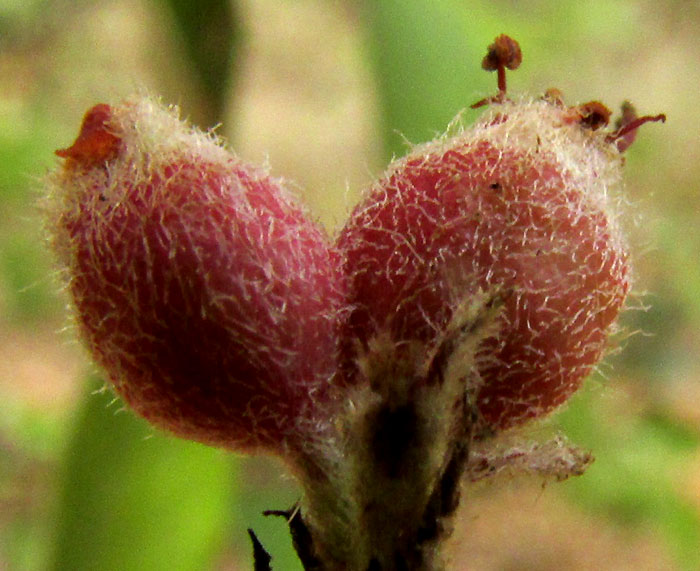
One branch on the entire tree bore the immature fruits shown above. With most flower buds not yet open, these immature fruits seemed out of sync. Maybe a limited flowering occurred in May or so, when the rainy season was supposed to come, but when it didn't most flowers aborted, except for two flowers forming these fruits. Maybe we're seeing the second flowering here, despite the drought continuing. Atop the immature fruit on the right, brown, dried-up stamens can be seen. That means that the flowers produce "inferior ovaries," because in flowers with superior ovaries, stamens arise below the ovary.
For identification purposes, this is an important field mark because many plant families develop only superior ovaries. In fact, the above developing fruit topped with brown, shriveled stamens is so similar to a rose hip -- the fruit of a rose flower -- that at this point our tree looks like a member of the Rose Family, the Rosaceae.
To round out our observations, here's what a leaf looked like:
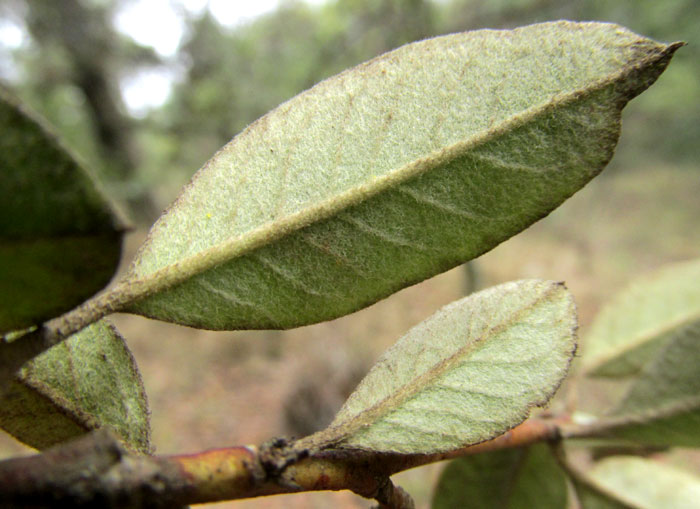
The leaf itself was somewhat stiff and the undersurface was densely white-hairy. The leaf's tip was equipped with a short, hard tip, a "mucro." Toward the blade tip the margins showed vague hints of forming teeth. Later I would learn that on many trees of this species a few low but distinct teeth do form near leaf tips.
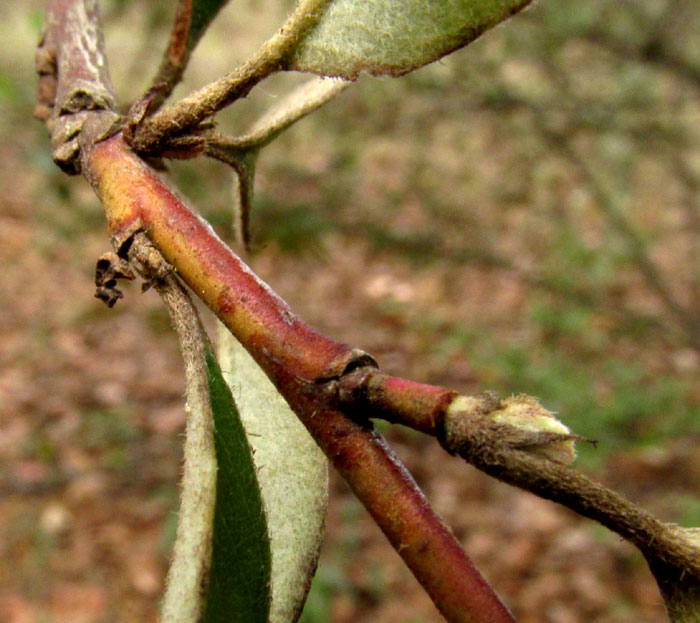
The tree's young stems were smooth with little hairiness, showing hues of yellow and rose. Note the slender, brown stipule arising next to the hairy bud on the picture's left. That's just the kind of stipule to be seen on many woody, Rose Family species.
Species in the Rose Family occur mostly in the world's north-temperate regions. In the Temperate Zone it's a fairly large family consisting of about 88 genera and some 3000 species. The family is important because of its edible fruits: apples, plums, cherries, peaches, strawberries, blackberries, plus it produces many ornamentals, especially the roses, pyracanthas and more. In Mexico, species in the family occur mostly at cool, high elevations, such as here.
In Mexico, if you have a woody tree with no spines producing flowers with inferior ovaries that develop into apple-like fruits, and with leaves that are white hairy underneath, you have either the genus Amelanchier or Malacomeles. A few years ago you'd have only one choice, the Amelanchier, whose species in the North we call serviceberries. But now they've busted up the serviceberries, and our tree turns out to a Malacomeles, a genus comprising only two species, of which one is our tree. It's MALACOMELES DENTICULATA, in many publications still identified as Amelanchier denticulata.
Malacomeles denticulata is known in English as the Southern False Serviceberry, and also the Big Bend Serviceberry, because it occurs in a small area of extreme western Texas, in the Big Bend region. Mainly it's a Mexican tree, though, extending a bit into Guatemala. Both the Texas and Guatemalan populations are isolated from the species' main body, which occupies upland central Mexico from the north to the south, with us in the heart of its greatest presence. It's regarded as relatively common, especially in disturbed scrub and grasslands, as well as forests of oak and pine, at altitudes from 1350-2950m (4400-9700ft).
Growing up in Kentucky in the southeastern US, I knew serviceberry trees very well. Ours were Amalanchier arborea, and in the spring it was always a pleasure to see them in full bloom. Kentuckians tend to call the trees sarviceberries. The fruits are like little apples, edible but not great, but loaded with nutrients. I'd nibble on them walking through the woods. To me, our Mexican tree looks like it should be a regular serviceberry, not a false one.
However, modern gene sequencing has decided that it's not quite a real member of the genus Amelanchier, and the story told by the genes of the two species assigned to the false serviceberry genus, Malacomeles, is interesting.
The 2020 work by Bin-Bin Liu and others entitled "Phylogenetic relationships and chloroplast capture in the Amelanchier-Malacomeles-Peraphyllum clade (Maleae, Rosaceae): evidence from chloroplast genome and nuclear ribosomal DNA data using genome skimming" sums up the story like this:
"The ancestor of Malacomeles captured the chloroplast genome of the ancestor of the western North American-Eurasian Amelanchier"
"Chloroplast capture" occurs when individuals from two different species mate, producing hybrid offspring, then later a hybrid descendant mates, or "backcrosses," with one of the original parent species or an organism genetically similar to the parent. From this backcrossing, a whole new species can arise different from both the two original parent species and the first-generation hybrid species. Wikipedia has a hard-to-follow Chloroplast Capture page.
Wildlife and people feed on the cherry-sized fruits, and studies have suggested planting the species as a nutritious food source in semi-arid environments too dry for other crops. María C. Cazares-Franco and others, who call our plant the Mexican Serviceberry, in their 2014 study "Physicochemical, nutritional and health-related component characterization of the underutilized Mexican serviceberry fruit [Malacomeles denticulata(Kunth) G.N. Jones]" conclude that "Contents of antioxidant compounds and the outstanding antioxidant activities of wild and cultivated Mexican Serviceberry make this species a natural resource that could contribute to health."
Entry from field notes dated June 28, 2023, taken beside gravel road at the ridge crest rising on the southwestern side of Curva de la Doctorcilla, which is near km 18 on the branch road beginning at El Campamento and continuing to El Doctor, and which is numbered Hwy 120, though it branches off the main Hwy 120 running between San Juan del Río and Jalpan; limestone bedrock; elevation of ~2930m (~9600 ft), Querétaro, MÉXICO, (N20.85971°, W99.60541°)
SOUTHERN FALSE SERVICEBERRY DIFFERENT APPEARANCE

At the ridge crest the limestone soil was thin and red, with boulder-sized limestone rocks rising above the soil to about knee high. It was classic cutter and pinnacle karst topography of landscapes with limestone bedrock. The narrow ridge was so exposed that trees and other woody bushes grew smaller and more compact than in more sheltered spots. The above branch with my tent's rain fly as a background is much more gnarly and compact than this species' branches seen earlier. The mature tree was about 2.5m tall (8ft).

The above shows one of the very few flowering branches on any of the trees or bushes. The flowers' orange items are petals that normally when just emerged are white, but possibly a late frost hurt them, or maybe with the current severe, long-term drought there wasn't enough rainfall for them to develop properly.
It's interesting to compare this plant with the one profiled above, met with about a week later in the season than this time, also in Querétaro state, but now higher at ~2930m (~9600 ft), not the earlier ~2700m (~8850 ft).